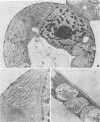Abstract
The fatty acids of the major glycerolipids from the leaves of Vicia faba and Hordeum vulgare plants treated with three different concentrations of pyridazinone derivatives were analyzed. These compounds showed multiple effects on the levels of lipids and pigments. At low concentrations, the primary effect of San 9785 was on the level of linolenic acid (18:3) in the galactolipids of V. faba, whereas the effect of San 6706 was primarily on the trans-Δ3-hexadecenoic acid (16:1) content in phosphatidylglycerol. At higher concentrations, the two compounds reduced the content of both fatty acids in the leaves. The results appear to indicate a differential effect of these herbicides on fatty acid accumulation and a difference in susceptibility of two fatty acids in the species examined. Electron microscopic studies revealed that two herbicides caused different abnormalities in V. faba chloroplast ultrastructure.
Full text
PDF





Images in this article
Selected References
These references are in PubMed. This may not be the complete list of references from this article.
- Arnon D. I. COPPER ENZYMES IN ISOLATED CHLOROPLASTS. POLYPHENOLOXIDASE IN BETA VULGARIS. Plant Physiol. 1949 Jan;24(1):1–15. doi: 10.1104/pp.24.1.1. [DOI] [PMC free article] [PubMed] [Google Scholar]
- Bartels P. G., Hyde A. Chloroplast Development in 4-Chloro-5-(dimethylamino)-2-(alpha,alpha,alpha-trifluoro-m-tolyl)-3 (2H)-pyridazinone (Sandoz 6706)-treated Wheat Seedlings: A Pigment, Ultrastructural, and Ultracentrifugal Study. Plant Physiol. 1970 Jun;45(6):807–810. doi: 10.1104/pp.45.6.807. [DOI] [PMC free article] [PubMed] [Google Scholar]
- Bartels P. G., McCullough C. A new inhibitor of carotenoid synthesis in higher plants: 4-chloro-5-(dimethylamino)-2- , , ,(trifluoro-m-tolyl)-3(2H)-pyridazinone. Biochem Biophys Res Commun. 1972 Jul 11;48(1):16–22. doi: 10.1016/0006-291x(72)90337-3. [DOI] [PubMed] [Google Scholar]
- Feierabend J., Schubert B. Comparative Investigation of the Action of Several Chlorosis-inducing Herbicides on the Biogenesis of Chloroplasts and Leaf Microbodies. Plant Physiol. 1978 Jun;61(6):1017–1022. doi: 10.1104/pp.61.6.1017. [DOI] [PMC free article] [PubMed] [Google Scholar]
- John J. B., Christiansen M. N. Inhibition of linolenic Acid synthesis and modification of chilling resistance in cotton seedlings. Plant Physiol. 1976 Feb;57(2):257–259. doi: 10.1104/pp.57.2.257. [DOI] [PMC free article] [PubMed] [Google Scholar]
- John J. B. Manipulation of galactolipid Fatty Acid composition with substituted pyridazinones. Plant Physiol. 1976 Jan;57(1):38–40. doi: 10.1104/pp.57.1.38. [DOI] [PMC free article] [PubMed] [Google Scholar]




